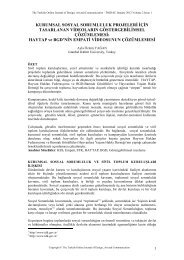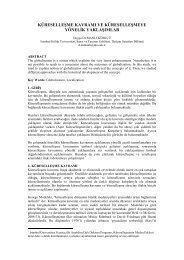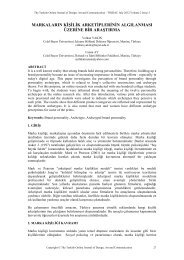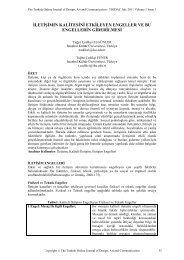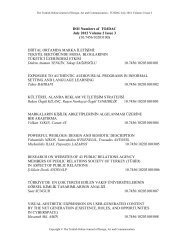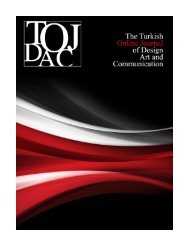aprıl 2012 - tojdac.org
aprıl 2012 - tojdac.org
aprıl 2012 - tojdac.org
Create successful ePaper yourself
Turn your PDF publications into a flip-book with our unique Google optimized e-Paper software.
The Turkish Online Journal of Design, Art and Communication - TOJDAC April <strong>2012</strong> Volume 2 Issue 2<br />
VISUAL EFFECTS CINEMATOGRAPHY<br />
THE CINEMATOGRAPHER’S FILMIC TECHNIQUE FROM<br />
TRADITIONAL TO DIGITAL ERA<br />
Nawal Mohamed Salah ELDIN<br />
College of Applied Sciences,Ibri, Sultanate of Oman<br />
nawals.ibr@cas.edu.om<br />
ABSTRACT<br />
Special effects cinematography is as old as cinema itself. The cinematographer had a major<br />
role in making the special effects scene either by making the whole effect in camera or<br />
combined with the optical effects in laboratory after shooting. A question pops up after the<br />
digital revolution: Does the cinematographer have the same role as before Is there a need to<br />
adopt new techniques to master the cinematographer work in the digital era This paper<br />
attempts to explore the differences between the conventional and the digital visual effects<br />
from the cinematographer’s technical point of view, based on a comparative study. Before the<br />
digital era most of the effects were done by the camera or in the laboratory. Nowadays,<br />
however, there are new tools and techniques such as digital visual effects that overruled the<br />
cinema industry, sometimes the only live-action elements are the actors. The term CGI<br />
(Computer Generated Images) is currently well known to many people and filming is only the<br />
first step to be followed by many other procedures. The mentioned procedures are called post<br />
production, which is the region where most of the visual effects creation takes place.<br />
Keywords: Cinematography, Digitalization, Visual Effects<br />
1. INTRODUCTION<br />
‘Special effects’ are created where techniques beyond the ‘normal’ film making procedures<br />
are used. That is to say when things might be more complex or time-consuming or involve<br />
‘special’ techniques. ‘Special’ effects, as currently defined, would be where modifications are<br />
made physically to any of these elements or the interfaces between them.[1] visual<br />
effects (also called optical or photographic effects) are special effects achieved with the aid of<br />
photographic or digital technology, occurring after the principal photography, or main<br />
shooting, of a film. Includes miniatures, optical and digital effects, matte paintings, stopmotion<br />
animation, and computer-generated imagery (CGI).[2]<br />
2. VISUAL EFFECTS: THE DEFINITION<br />
Until fairly recently, the art and craft of visual effects went by the name special photographic<br />
effects because the work was accomplished photographically on film and relied heavily on<br />
special optical cameras called optical printers. Most of the serious visual effects work took<br />
place in postproduction. Nowadays we simply call it visual effects. But even defining a visual<br />
effect is far from straightforward. For one thing, some people include visual effects in the<br />
general category of special effects, while others may refer to them as special visual effects.<br />
Before the introduction of computer graphics, it was relatively easy to say what a visual effect<br />
was: If a shot required some sort of treatment in postproduction and rephotographing on an<br />
optical printer, it was called a “special photographic effect.” John Dykstra, one of the top<br />
visual effects supervisors in the business today (and one of the main creative forces behind<br />
the visual effects for the seminal film Star Wars of 1977), once defined a visual effect as “two<br />
or more elements of film combined into a single image.” [3]<br />
Copyright © The Turkish Online Journal of Design, Art and Communication 115




